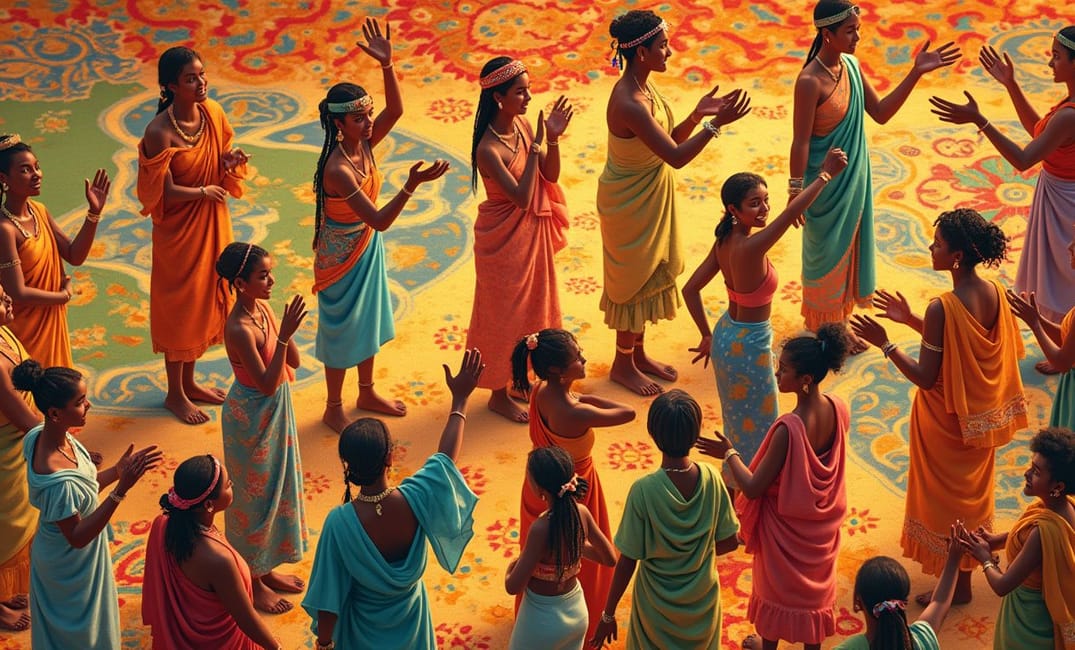Introduction: Threads of Continuity in a Changing World
Throughout history, human societies have crafted intricate tapestries of tradition, weaving together rituals, customs, and cultural rites that provide continuity and identity. These traditions serve as anchors in an ever-shifting world, offering a sense of belonging, structure, and meaning. They connect us to our ancestors, guide our actions, and shape communal identities. This entry delves into the role and evolution of human traditions, revealing their universal significance in fostering social cohesion and individual identity.
The Foundations of Tradition: Cultural and Societal Roots
Origins and Functions of Rituals
- Defining Rituals and Traditions: Rituals are ceremonial acts that embody the collective values, beliefs, and social norms of a community. Traditions, derived from accumulated rituals over generations, serve as a framework for cultural identity and continuity.
- Functions of Rituals: Rituals play crucial roles in marking life transitions, reinforcing social bonds, and conveying cultural values. Whether celebrating birth, coming of age, marriage, or mourning death, these practices provide a shared language for expressing significant human experiences.
Evolutionary Perspectives on Tradition
- Social Cohesion and Tradition: Anthropologists propose that the evolution of complex social structures is deeply linked to tradition and ritual, which serve to bind groups, establish hierarchies, and foster cooperation—essential components for survival in early human societies.
- Transmission of Knowledge and Skills: Through oral traditions, storytelling, and shared practices, societies have traditionally passed down critical knowledge, skills, and histories. This transmission ensures the preservation of cultural heritage and supports societal resilience amidst change.
The Diversity of Rituals: Cultural Expressions Across the Globe
Universal Elements and Distinct Traditions
- Cross-Cultural Commonalities: While rituals are highly diverse, some universal elements include symbolic language, formalized actions, repetition, and community participation. These elements facilitate shared understanding and collective meaning-making.
- Distinct Cultural Practices: Each culture boasts unique expressions of its values and worldviews through specific rituals. Consider the Dia de los Muertos in Mexico, a vibrant celebration of life and death, or Japan’s tea ceremony, "Chanoyu," embodying principles of harmony, respect, and tranquility.
Religious and Spiritual Rituals
- Sacred Rites and Worship: Religious rituals often involve sacred ceremonies that honor deities, symbolically express belief systems, and seek spiritual connection. Examples include Hindu pujas, Islamic prayers, Christian communions, and Shamanic rites.
- Pilgrimages and Sacred Journeys: Many traditions incorporate pilgrimages—journeys to sacred sites carrying deep spiritual significance. Through rites at sites like Mecca, Santiago de Compostela, and the River Ganges, pilgrims engage in transformative spiritual quests.
Secular and Civic Traditions
- National Festivals and Celebrations: National holidays commemorate historical events or cultural icons, fostering unity and patriotism. Bastille Day in France and the Fourth of July in the United States are examples of celebrations that affirm national identity.
- Civic Rituals and Community Building: Secular rituals, such as graduations, sports events, and community feasts, fortify social ties and promote a sense of belonging. These practices provide opportunities for affirming shared values and participating in communal life.
The Transformation of Tradition: Adapting in a Modern World
Dynamics of Traditions in Contemporary Societies
- Innovation and Change: Traditions are not static; they evolve in response to new influences, technologies, and social changes. As societies grow more interconnected, global cultural exchanges spur the adaptation and hybridization of traditional practices.
- Challenges to Continuity: Modernization, urbanization, and globalization can threaten traditional practices, leading to cultural homogenization or the dilution of heritage. The loss of indigenous languages and rituals illustrates the vulnerability of intangible cultural assets.
Preservation and Revitalization Efforts
- Cultural Conservation Initiatives: Organizations globally actively work to preserve cultural heritage, supporting indigenous communities in safeguarding languages, rituals, and traditional knowledge. UNESCO’s "Intangible Cultural Heritage" program highlights such efforts.
- The Role of Education and Technology: Education systems integrating cultural studies, alongside digital resourcing, play pivotal roles in revitalizing traditions. By recording, sharing, and teaching traditional practices, technology aids in sustaining cultural memory.
The Intersection of Tradition and Identity
- Individual and Collective Identity Formation: Traditions significantly shape personal and collective identities, influencing values, behaviors, and worldviews. Celebrations like rites of passage affirm and transmit cultural identities to successive generations.
- Hybrid and Evolving Identities: As individuals participate in multiple cultural spheres, hybrid identities emerge. These identities reflect the blending of traditional and contemporary cultural elements, demonstrating the adaptive nature of human culture.
Future Challenges and Opportunities in Upholding Traditions
The Role of Technology and Media
- Digital Platforms and Cultural Distribution: Digital media offer innovative ways to engage with traditions, allowing for virtual participation, documentation, and cultural exchange. As a tool, technology can support tradition continuity by broadening access to cultural practices.
- Challenges of Authenticity and Commodification: The global reach of digital platforms raises concerns about the commodification and misrepresentation of cultural traditions. Ensuring authenticity and respect in cultural sharing remains imperative in a digital era.
Fostering Inclusivity and Diversity
- Multicultural Societies and Integrative Practices: Embracing and celebrating cultural diversity can enrich societies, inspire innovation, and promote peace. Policies and initiatives that foster inclusivity in cultural practices strengthen social cohesion.
- Cross-Cultural Dialogue: Encouraging dialogue and understanding between diverse cultural groups enhances mutual respect and appreciation. Intercultural engagements provide opportunities to rediscover shared humanity amidst differences.
Cultural Heritage for Future Generations
- Educating Future Stewards: Educating young generations about the significance and value of traditions empowers them as stewards of cultural heritage. Encouraging engagement with traditional practices fosters a sense of responsibility in preserving cultural legacies.
- Adaptation and Growth: While respecting heritage's roots, allowing traditions to adapt and grow with changing contemporary values is crucial. This adaptation ensures that traditions remain relevant and meaningful for future societies.
Conclusion: The Tapestry of Tradition in Human Society
Traditions, with their roots planted deep in human history, serve as quilted symbols of continuity, diversity, and identity. As we celebrate this enduring fabric, nurturing traditions' evolving nature while preserving their core essence fosters societies that respect, honor, and learn from their heritages. It is through these shared legacies that communities weave resilience and meaning, passing the torch of culture, identities, and values from one generation to the next—a vibrant tapestry that extends the human journey, interconnected across time and space.
"In the weaving of tradition, every thread tells a story—a testament of humanity’s desire to find meaning in the tapestry of time, stitching together the echoes of the past and the dreams of the future."
IDENTITY, PRESERVATION, SOCIAL COHESION, EDUCATION, GLOBALIZATION, RITUALS, CULTURAL DIVERSITY, HUMAN TRADITIONS, CULTURAL HERITAGE, ADAPTATION

